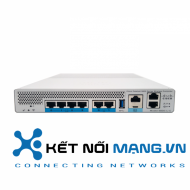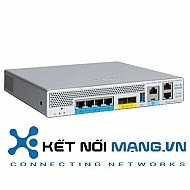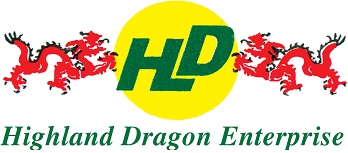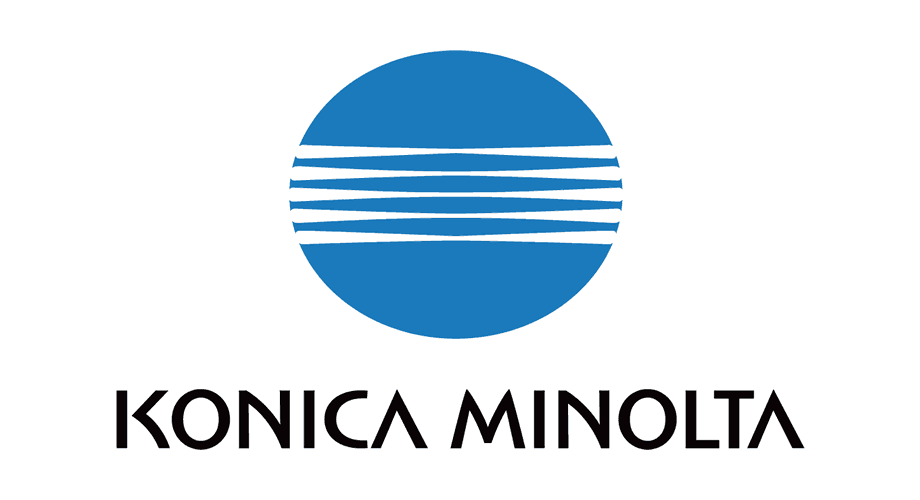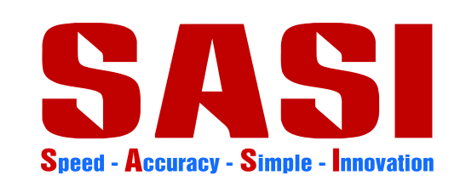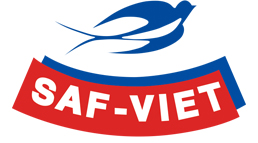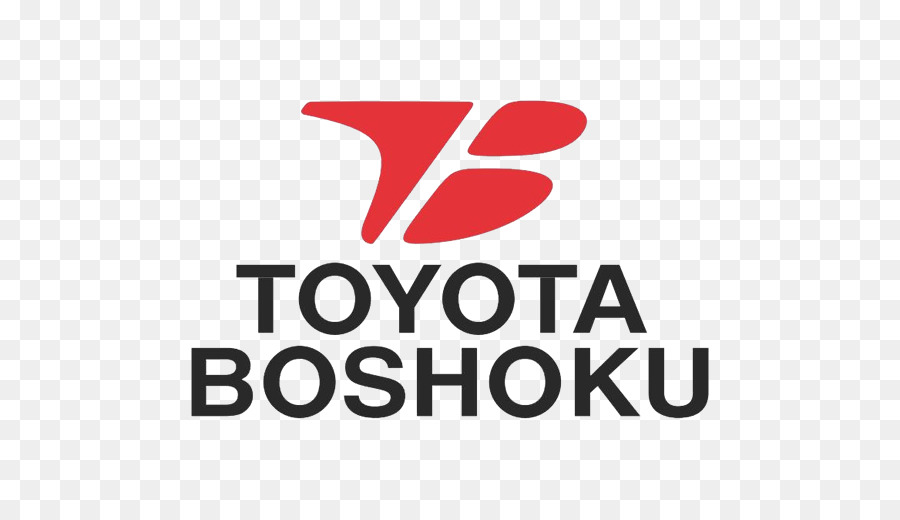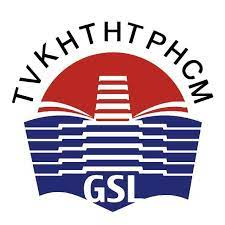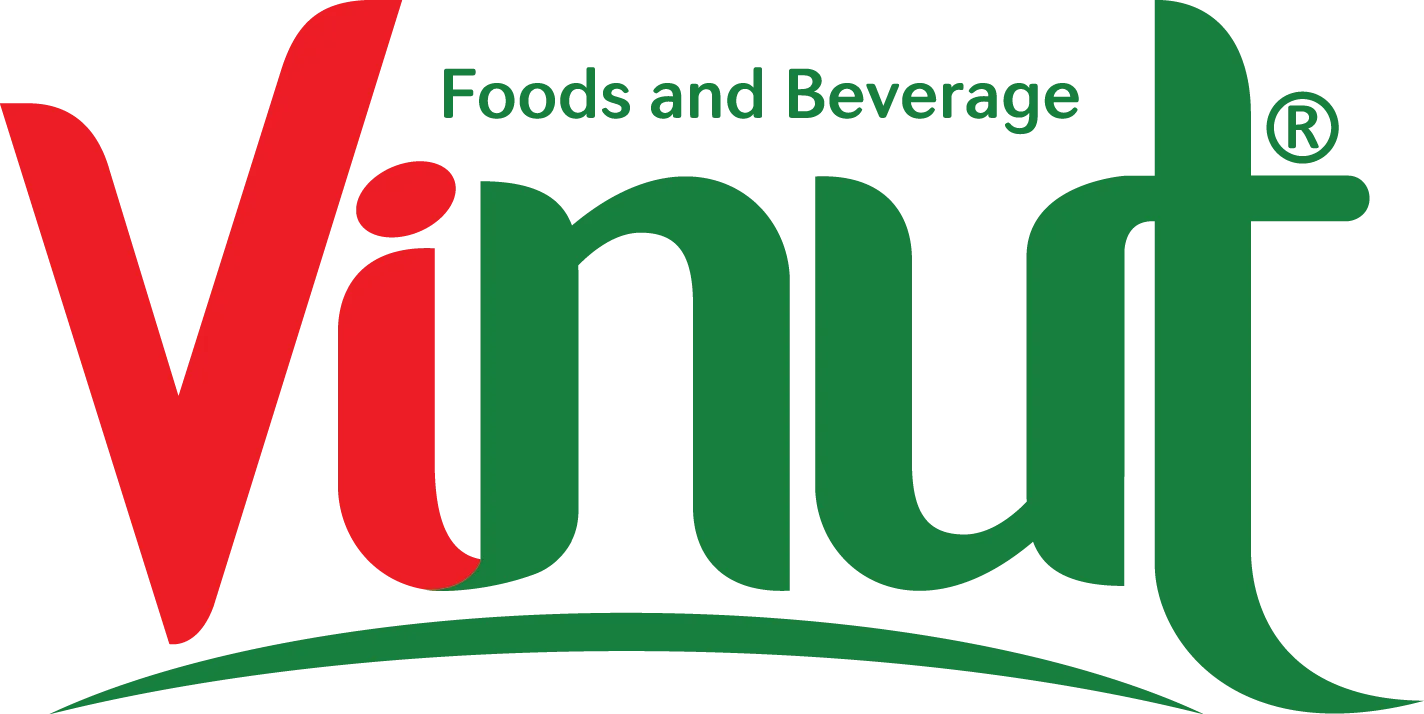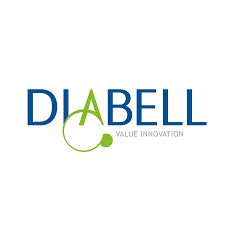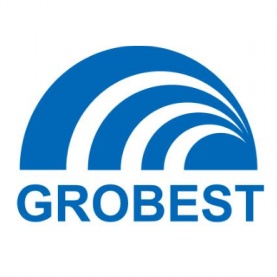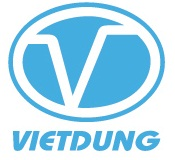Cisco Meraki MS120-8 Switch
Cisco Meraki MS120-48FP Switch
Cisco Meraki MS125-48FP Switch
Cisco Meraki MS125-24 Switch
Cisco Meraki MS120-48LP Switch
Cisco Meraki MS125-48 Switch
Cisco Meraki MS120-8LP Switch
Cisco Meraki MS125-24P Switch
Cisco Meraki MS125-48LP Switch

Bộ điều khiển không dây Cisco Catalyst C9800-80-K9 Wireless Controller
P/N: C9800-80-K9Cisco Catalyst 9800-80 Wireless Controller
Liên hệ ngay
Product Overview

Built from the ground-up for the Intent-based networking and Cisco DNA, Cisco Catalyst 9800 Series Wireless Controllers are Cisco IOS® XE based and integrate the RF excellence of Cisco Aironet® access points creating the best-in-class wireless experience for your evolving and growing organization. The Cisco Catalyst 9800 Series Wireless Controllers are built on an open and programmable architecture with built-in security, streaming telemetry and rich analytics.
The Cisco Catalyst 9800 Series Wireless Controllers are built on the three pillars of network excellence—always on, secure, and deployed anywhere—which strengthen the network by providing the best wireless experience without compromise, while saving time and money.
The Cisco® Catalyst® 9800-80 is a modular wireless controller with optional 100 Gigabit Ethernet (GE) modular uplinks and seamless software updates for large enterprises and campuse.
The Cisco Catalyst 9800-80 is feature rich and enterprise ready to power your business-critical operations and transform end-customer experiences:
- High availability and seamless software updates, enabled by hot patching, keep your clients and services always on in planned and unplanned events.
- Secure air, devices, and users with the Cisco Catalyst 9800-80. Wireless infrastructure becomes the strongest first line of defense with Cisco Encrypted Traffic Analytics (ETA) and Software-Defined Access (SD-Access). The controller comes with built-in security: secure boot, runtime defenses, image signing, integrity verification, and hardware authenticity.
- Built on a modular operating system, the 9800-80 features open and programmable APIs that enable automation of day-0 to day-N network operations. Model-driven streaming telemetry provides deep insights into the health of your network and clients.
Features
|
Metric |
Value |
|
Maximum number of access points |
Up to 6000 |
|
Maximum number of clients |
64,000 |
|
Maximum throughput |
Up to 80 Gbps |
|
Maximum WLANs |
4096 |
|
Maximum VLANs |
4096 |
|
Max site tags |
6000 |
|
Max Flex APs per site |
100 |
|
Max policy tags |
6000 |
|
Max RF tags |
6000 |
|
Max RF profiles |
12000 |
|
Max policy profiles |
1000 |
|
Max flex profiles |
6000 |
|
Fixed uplinks |
8x 10 GE or 6x 10 GE + 2x 1 GE SFP+/SFP |
|
Modular uplinks (optional) |
The supported uplink modules are: The uplink modules are hot-swappable. Supports 10 GE, 40 GE, and 100 GE QSFP transceivers |
|
Redundant power supply |
AC or DC power supply |
|
Maximum power consumption with modules |
600W |
|
Deployment modes |
Centralized, Cisco FlexConnect®, and Fabric Wireless (SD-Access) |
|
Form factor |
2RU |
|
License |
Smart License enabled |
|
Operating system |
Cisco IOS XE |
|
Management |
Cisco DNA Center 1.2.8, Cisco Prime® Infrastructure 3.5, integrated WebUI, and third party (open standards APIs) |
|
Interoperability |
AireOS-based controllers with 8.8 MR2, 8.5 MR4 and 8.5 MR3 special |
|
Policy engine |
Cisco Identity Services Engine (ISE) 2.2, 2.3, and 2.4 |
|
Cisco Connected Mobile Experiences (CMX) |
CMX 10.5.1 |
|
Access points |
Aironet 802.11ac Wave 1 and Wave 2 access points |
Always on
Seamless software updates enable faster resolution of critical issues, introduction of new access points with zero downtime, and flexible software upgrades. Stateful switchover (SSO) with 1:1 active standby and N+1 redundancy keeps your network, services, and clients always on, even in unplanned events.
Secure
Secure air, devices, and users with the Cisco Catalyst 9800-80 Wireless Controller. Wireless infrastructure becomes the strongest first line of defense with ETA and SD-Access. The controller comes with built-in security: secure boot, runtime defenses, image signing, integrity verification, and hardware authenticity.
Open and programmable
The controller is built on the Cisco IOS XE operating system, which offers a rich set of open standards-based programmable APIs and model-driven telemetry that provide an easy way to automate day-0 to day-N network operations.
Details

Physical dimensions
|
Dimension |
Value |
|
Width |
17.3 inches (43.94 cm) |
|
Depth |
20.5 inches (52.07 cm) |
|
Height |
3.47 inches (8.81 cm) |
|
Weight |
31.5 lb (14.29 kg) |
Front panel

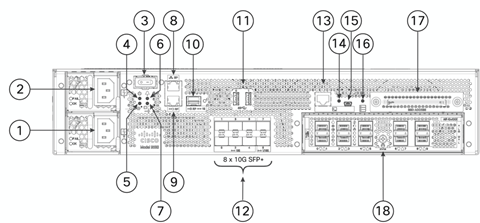
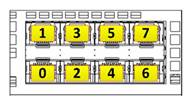
|
Label |
Component |
|
1 |
Power supply (PEM 0) |
|
2 |
Power supply (PEM 1) |
|
3 |
Power (PWR) switch |
|
4 |
PWR: Power LED |
|
5 |
SYS: System LED |
|
6 |
ALM: Alarm LED |
|
7 |
HA: High-availability LED |
|
8 |
SP: RJ-45 10/100/1000 management Ethernet port |
|
9 |
RP: RJ-45 10/100/1000 redundancy Ethernet port |
|
10 |
RP: 1 GE SFP port (the only SFPs supported on the RP port are GLC-SX-MMD and GLC-LH-SMD) |
|
11 |
USB ports 0 and 1 |
|
12 |
Fixed: 6x 10 GE and 2x 1 GE or 8x 10 GE |
|
13 |
CON: RJ-45 compatible console port |
|
14 |
LINK: RJ-45 connector LED |
|
15 |
CON: Mini USB console port |
|
16 |
SSD: SSD activity LED |
|
17 |
SSD access |
|
18 |
Modular uplink |
Ports
|
Port |
Purpose |
|
1x RJ-45 console port |
Console port for out-of-band management |
|
1x USB 3.0 console port |
Console port for out-of-band management |
|
2x USB 3.0 ports |
USB 3.0 ports for plugging in external memory |
|
1x RJ-45 management port |
Management port for out-of-band management. Also known as service port. |
|
1x RJ-45 redundancy port |
Redundancy port used for SSO |
|
1x SFP Gigabit Ethernet redundancy port |
|
|
Fixed uplink: 10 GE SFP+/1 GE SFP ports |
The ports are fixed uplinks, which can be used as 8x10 GE SFP+ or 6x 10 GE plus 2x 1 GE |
|
Modular uplink |
The supported uplink modules are: The uplink modules are hot-swappable. Supports 10 GE, 40 GE, and 100 GE QSFP transceivers |
Front panel LEDs
|
LED |
Color |
Function |
|
Power PWR |
Green |
Green if all power rails are within spec |
|
STATUS SYS |
Green |
On: IOS has boot complete Blinking: IOS boot in progress |
|
Amber |
On: System crash Blinking: Secure boot failure Off: ROMMON boot |
|
|
ALARM ALM |
Green |
On: ROMMON boot complete Blinking: System upgrade in progress |
|
Amber |
On: ROMMON boot and SYSTEM bootup Blinking: Temperature error and secure boot failure |
|
|
HIGH AVAILABILITY HA |
Green |
On: HA active Blinking: HA standby hot |
|
Amber |
Slow blink: Booted with HA standby cold Fast blink: HA maintenance |
|
|
USB CON ENABLED EN |
Green |
When LED is lit, USB console is enabled (RJ-45 console is disabled) |
|
10/100/1000 RJ45 I/F LINK |
Green |
Solid green indicates link |
|
10/100/1000 RJ45 I/F ACTIVITY |
Green |
Flashing green indicates activity |
|
SSD Activity SSD |
Green |
Indicates active use of the hard disk SSD memory devices in the unit |
Rear panel

- The chassis has a front-to-rear airflow.
- Four internal fans draw cooling air in through the front of the chassis and across the internal components to maintain an acceptable operating temperature.
- The fans are located at the rear of the chassis.
- The fans are numbered from 0 to 3, right to left.
Power
The 9800-80 controller ships with redundant power supply units, either AC or DC, based on the customer’s choice.
The Power Entry Module (PEM) provides redundant power to the system, and the 9800-80 can operate continuously with only a single PEM installed. The PEMs are hot-swappable, and replacement of a single PEM can be made without power interruption to the system. All external connections to the PEMs are made from the rear panel of the chassis, and they are removed or inserted from the rear. The main power switch for the unit is located directly next to the PEMs on the rear of the chassis.
|
Power supply condition |
Green (OK) LED status |
Amber (Fail) LED status |
|
No AC power to all power supplies |
Off |
Off |
|
Power supply failure (includes over voltage, over current, over temperature, and fan failure) |
Off |
Red for power supply failure Amber for fan failure |
|
Power supply warning events in which the power supply continues to operate (high temperature, high power, and slow fan) |
Off |
1 Hz blinking |
Note: Redundancy is supported with the same power supply types.
SFPs supported
- All 1 GE, 10 GE, 40 GE, and 100 GE ports can be configured independently.
- Online Insertion and Removal (OIR) for SFP, SFP+, and QSFP.
- Modules are hot-swappable.
|
Type |
Modules supported |
|
Small Form-Factor Pluggable (SFP) |
GLC-BX-D |
|
GLC-BX-U |
|
|
GLC-LH-SMD |
|
|
GLC-SX-MMD |
|
|
GLC-ZX-SMD |
|
|
GLC-TE |
|
|
Enhanced SFP (SFP+) |
SFP-10G-SR |
|
SFP-10G-SR-S |
|
|
SFP-10G-SR-X |
|
|
SFP-10G-LR |
|
|
SFP-10G-LRM |
|
|
SFP-10G-LR-X |
|
|
SFP-10G-ER |
|
|
SFP-10G-ZR |
|
|
SFP-H10GB-ACU7M |
|
|
SFP-H10GB-ACU10M |
|
|
DWDM-SFP10G-30.33 - DWDM-SFP10G-61.41 |
|
|
Quad SFP (QSFP) |
QSFP-40G-SR4 |
|
QSFP-40G-LR4 |
|
|
QSFP-40GE-LR4 |
|
|
QSFP-40G-ER4 |
|
|
QSFP-40G-SR4-S |
|
|
QSFP-40G-LR4-S |
|
|
QSFP-40G-SR-BD |
|
|
QSFP-40G-BD-RX |
|
|
QSFP-100G-SR4-S |
|
|
QSFP-100G-LR4-S |
Benefits
Cisco IOS XE opens a completely new paradigm in network configuration, operation, and monitoring through network automation. Cisco’s automation solution is open, standards-based, and extensible across the entire lifecycle of a network device. The various mechanisms that bring about network automation are outlined below, based on a device lifecycle.
- Automated device provisioning: This is the ability to automate the process of upgrading software images and installing configuration files on Cisco access points when they are being deployed in the network for the first time. Cisco provides turnkey solutions such as Plug and Play (PnP) that enable an effortless and automated deployment.
- API-driven configuration: Modern wireless controllers such the Cisco Catalyst 9800-80 Wireless Controller support a wide range of automation features and provide robust open APIs over Network Configuration Protocol (NETCONF) using YANG data models for external tools, both off-the-shelf and custom built, to automatically provision network resources.
- Granular visibility: Model-driven telemetry provides a mechanism to stream data from a wireless controller to a destination. The data to be streamed is driven through subscription to a data set in a YANG model. The subscribed data set is streamed out to the destination at configured intervals. Additionally, Cisco IOS XE enables the push model, which provides near-real-time monitoring of the network, leading to quick detection and rectification of failures.
- Seamless software upgrades and patching: To enhance OS resilience, Cisco IOS XE supports patching, which provides fixes for critical bugs and security vulnerabilities between regular maintenance releases. This support allows customers to add patches without having to wait for the next maintenance release.
Always on
- High availability: Stateful switchover with 1:1 active standby and N+1 redundancy keeps your network, services, and clients always on, even in unplanned events.
- Software Maintenance Upgrades (SMUs) with hot patching: Patching allows for a patch to be installed as a bug fix without bringing down the entire network and eliminates the need to requalify an entire software image. The SMU is a package that can be installed on a system to provide a patch fix or security resolution to a released image. SMUs allow you to address the network issue quickly while reducing the time and scope of the testing required. The Cisco IOS XE platform internally validates the SMU compatibility and does not allow you to install incompatible SMUs. All SMUs are integrated into the subsequent Cisco IOS XE Software maintenance releases.
- Intelligent rolling access point upgrades and seamless multisite upgrades: The Cisco Catalyst 9800-80 Wireless Controller comes equipped with intelligent rolling access point upgrades to simplify network operations. Multisite upgrades can now be done in stages, and access points can be upgraded intelligently without restarting the entire network
Security
- Encrypted Traffic Analytics (ETA): ETA is a unique capability for identifying malware in encrypted traffic coming from the access layer. Since more and more traffic is being encrypted, the visibility this feature provides related to threat detection is critical for keeping your network secure at different layers.
- Trustworthy systems: Cisco Trust Anchor Technologies provide a highly secure foundation for Cisco products. With the Cisco Catalyst 9800-80, these trustworthy systems help assure hardware and software authenticity for supply chain trust and strong mitigation against man-in-the-middle attacks on software and firmware. Trust Anchor capabilities include:
- Image signing: Cryptographically signed images provide assurance that the firmware, BIOS, and other software are authentic and unmodified. As the system boots, its software signatures are checked for integrity.
- Secure boot: Cisco Secure Boot technology anchors the boot sequence chain of trust to immutable hardware, mitigating threats against a system's foundational state and the software that is to be loaded, regardless of a user's privilege level. It provides layered protection against the persistence of illicitly modified firmware.
- Cisco trust anchor module: A tamper-resistant, strong cryptographic, single-chip solution hardware uniquely identifies the product so that its origin can be confirmed to Cisco, providing assurance that the product is genuine.
Flexible netFlow
Flexible NetFlow (FNF): Cisco IOS FNF is the next generation in flow visibility technology, allowing optimization of the network infrastructure, reducing operating costs, and improving capacity planning and security incident detection with increased flexibility and scalability.
Application visibility and control
Next-Generation Network-Based Application Recognition (NBAR2): NBAR2 enables advanced application classification techniques, with up to 1400 predefined and well-known application signatures and up to 150 encrypted applications on the Cisco Catalyst 9800-80. Some of the most popular applications included are Skype, Office 365, Microsoft Lync, Cisco Webex®, and Facebook. Many others are already predefined and easy to configure. NBAR2 provides the network administrator with an important tool to identify, control, and monitor end-user application usage while helping ensure a quality user experience and securing the network from malicious attacks. It uses FNF to report application performance and activities within the network to any supported NetFlow collector, such as Cisco Prime, Stealthwatch®, or any compliant third-party tool.
Quality of service
Superior Quality of Service (QoS): QoS technologies are tools and techniques for managing network resources and are considered the key enabling technologies for the transparent convergence of voice, video, and data networks. QoS on the Cisco Catalyst 9800-80 consists of classification of traffic based on packet data as well as application recognition and traffic control actions such as dropping, marking and policing. A modular QoS command-line framework provides consistent platform-independent and flexible configuration behavior. The 9800-80 also supports policies at two levels of target: BSSID as well as client. Policy assignment can be granular
Product Overview
Built from the ground-up for the Intent-based networking and Cisco DNA, Cisco Catalyst 9800 Series Wireless Controllers are Cisco IOS® XE based and integrate the RF excellence of Cisco Aironet® access points creating the best-in-class wireless experience for your evolving and growing organization. The Cisco Catalyst 9800 Series Wireless Controllers are built on an open and programmable architecture with built-in security, streaming telemetry and rich analytics.
The Cisco Catalyst 9800 Series Wireless Controllers are built on the three pillars of network excellence—always on, secure, and deployed anywhere—which strengthen the network by providing the best wireless experience without compromise, while saving time and money.
The Cisco® Catalyst® 9800-80 is a modular wireless controller with optional 100 Gigabit Ethernet (GE) modular uplinks and seamless software updates for large enterprises and campuse.
The Cisco Catalyst 9800-80 is feature rich and enterprise ready to power your business-critical operations and transform end-customer experiences:
- High availability and seamless software updates, enabled by hot patching, keep your clients and services always on in planned and unplanned events.
- Secure air, devices, and users with the Cisco Catalyst 9800-80. Wireless infrastructure becomes the strongest first line of defense with Cisco Encrypted Traffic Analytics (ETA) and Software-Defined Access (SD-Access). The controller comes with built-in security: secure boot, runtime defenses, image signing, integrity verification, and hardware authenticity.
- Built on a modular operating system, the 9800-80 features open and programmable APIs that enable automation of day-0 to day-N network operations. Model-driven streaming telemetry provides deep insights into the health of your network and clients.
Features
|
Metric |
Value |
|
Maximum number of access points |
Up to 6000 |
|
Maximum number of clients |
64,000 |
|
Maximum throughput |
Up to 80 Gbps |
|
Maximum WLANs |
4096 |
|
Maximum VLANs |
4096 |
|
Max site tags |
6000 |
|
Max Flex APs per site |
100 |
|
Max policy tags |
6000 |
|
Max RF tags |
6000 |
|
Max RF profiles |
12000 |
|
Max policy profiles |
1000 |
|
Max flex profiles |
6000 |
|
Fixed uplinks |
8x 10 GE or 6x 10 GE + 2x 1 GE SFP+/SFP |
|
Modular uplinks (optional) |
The supported uplink modules are: The uplink modules are hot-swappable. Supports 10 GE, 40 GE, and 100 GE QSFP transceivers |
|
Redundant power supply |
AC or DC power supply |
|
Maximum power consumption with modules |
600W |
|
Deployment modes |
Centralized, Cisco FlexConnect®, and Fabric Wireless (SD-Access) |
|
Form factor |
2RU |
|
License |
Smart License enabled |
|
Operating system |
Cisco IOS XE |
|
Management |
Cisco DNA Center 1.2.8, Cisco Prime® Infrastructure 3.5, integrated WebUI, and third party (open standards APIs) |
|
Interoperability |
AireOS-based controllers with 8.8 MR2, 8.5 MR4 and 8.5 MR3 special |
|
Policy engine |
Cisco Identity Services Engine (ISE) 2.2, 2.3, and 2.4 |
|
Cisco Connected Mobile Experiences (CMX) |
CMX 10.5.1 |
|
Access points |
Aironet 802.11ac Wave 1 and Wave 2 access points |
Always on
Seamless software updates enable faster resolution of critical issues, introduction of new access points with zero downtime, and flexible software upgrades. Stateful switchover (SSO) with 1:1 active standby and N+1 redundancy keeps your network, services, and clients always on, even in unplanned events.
Secure
Secure air, devices, and users with the Cisco Catalyst 9800-80 Wireless Controller. Wireless infrastructure becomes the strongest first line of defense with ETA and SD-Access. The controller comes with built-in security: secure boot, runtime defenses, image signing, integrity verification, and hardware authenticity.
Open and programmable
The controller is built on the Cisco IOS XE operating system, which offers a rich set of open standards-based programmable APIs and model-driven telemetry that provide an easy way to automate day-0 to day-N network operations.
Details
Physical dimensions
|
Dimension |
Value |
|
Width |
17.3 inches (43.94 cm) |
|
Depth |
20.5 inches (52.07 cm) |
|
Height |
3.47 inches (8.81 cm) |
|
Weight |
31.5 lb (14.29 kg) |
Front panel
|
Label |
Component |
|
1 |
Power supply (PEM 0) |
|
2 |
Power supply (PEM 1) |
|
3 |
Power (PWR) switch |
|
4 |
PWR: Power LED |
|
5 |
SYS: System LED |
|
6 |
ALM: Alarm LED |
|
7 |
HA: High-availability LED |
|
8 |
SP: RJ-45 10/100/1000 management Ethernet port |
|
9 |
RP: RJ-45 10/100/1000 redundancy Ethernet port |
|
10 |
RP: 1 GE SFP port (the only SFPs supported on the RP port are GLC-SX-MMD and GLC-LH-SMD) |
|
11 |
USB ports 0 and 1 |
|
12 |
Fixed: 6x 10 GE and 2x 1 GE or 8x 10 GE |
|
13 |
CON: RJ-45 compatible console port |
|
14 |
LINK: RJ-45 connector LED |
|
15 |
CON: Mini USB console port |
|
16 |
SSD: SSD activity LED |
|
17 |
SSD access |
|
18 |
Modular uplink |
Ports
|
Port |
Purpose |
|
1x RJ-45 console port |
Console port for out-of-band management |
|
1x USB 3.0 console port |
Console port for out-of-band management |
|
2x USB 3.0 ports |
USB 3.0 ports for plugging in external memory |
|
1x RJ-45 management port |
Management port for out-of-band management. Also known as service port. |
|
1x RJ-45 redundancy port |
Redundancy port used for SSO |
|
1x SFP Gigabit Ethernet redundancy port |
|
|
Fixed uplink: 10 GE SFP+/1 GE SFP ports |
The ports are fixed uplinks, which can be used as 8x10 GE SFP+ or 6x 10 GE plus 2x 1 GE |
|
Modular uplink |
The supported uplink modules are: The uplink modules are hot-swappable. Supports 10 GE, 40 GE, and 100 GE QSFP transceivers |
Front panel LEDs
|
LED |
Color |
Function |
|
Power PWR |
Green |
Green if all power rails are within spec |
|
STATUS SYS |
Green |
On: IOS has boot complete Blinking: IOS boot in progress |
|
Amber |
On: System crash Blinking: Secure boot failure Off: ROMMON boot |
|
|
ALARM ALM |
Green |
On: ROMMON boot complete Blinking: System upgrade in progress |
|
Amber |
On: ROMMON boot and SYSTEM bootup Blinking: Temperature error and secure boot failure |
|
|
HIGH AVAILABILITY HA |
Green |
On: HA active Blinking: HA standby hot |
|
Amber |
Slow blink: Booted with HA standby cold Fast blink: HA maintenance |
|
|
USB CON ENABLED EN |
Green |
When LED is lit, USB console is enabled (RJ-45 console is disabled) |
|
10/100/1000 RJ45 I/F LINK |
Green |
Solid green indicates link |
|
10/100/1000 RJ45 I/F ACTIVITY |
Green |
Flashing green indicates activity |
|
SSD Activity SSD |
Green |
Indicates active use of the hard disk SSD memory devices in the unit |
Rear panel
- The chassis has a front-to-rear airflow.
- Four internal fans draw cooling air in through the front of the chassis and across the internal components to maintain an acceptable operating temperature.
- The fans are located at the rear of the chassis.
- The fans are numbered from 0 to 3, right to left.
Power
The 9800-80 controller ships with redundant power supply units, either AC or DC, based on the customer’s choice.
The Power Entry Module (PEM) provides redundant power to the system, and the 9800-80 can operate continuously with only a single PEM installed. The PEMs are hot-swappable, and replacement of a single PEM can be made without power interruption to the system. All external connections to the PEMs are made from the rear panel of the chassis, and they are removed or inserted from the rear. The main power switch for the unit is located directly next to the PEMs on the rear of the chassis.
|
Power supply condition |
Green (OK) LED status |
Amber (Fail) LED status |
|
No AC power to all power supplies |
Off |
Off |
|
Power supply failure (includes over voltage, over current, over temperature, and fan failure) |
Off |
Red for power supply failure Amber for fan failure |
|
Power supply warning events in which the power supply continues to operate (high temperature, high power, and slow fan) |
Off |
1 Hz blinking |
Note: Redundancy is supported with the same power supply types.
SFPs supported
- All 1 GE, 10 GE, 40 GE, and 100 GE ports can be configured independently.
- Online Insertion and Removal (OIR) for SFP, SFP+, and QSFP.
- Modules are hot-swappable.
|
Type |
Modules supported |
|
Small Form-Factor Pluggable (SFP) |
GLC-BX-D |
|
GLC-BX-U |
|
|
GLC-LH-SMD |
|
|
GLC-SX-MMD |
|
|
GLC-ZX-SMD |
|
|
GLC-TE |
|
|
Enhanced SFP (SFP+) |
SFP-10G-SR |
|
SFP-10G-SR-S |
|
|
SFP-10G-SR-X |
|
|
SFP-10G-LR |
|
|
SFP-10G-LRM |
|
|
SFP-10G-LR-X |
|
|
SFP-10G-ER |
|
|
SFP-10G-ZR |
|
|
SFP-H10GB-ACU7M |
|
|
SFP-H10GB-ACU10M |
|
|
DWDM-SFP10G-30.33 - DWDM-SFP10G-61.41 |
|
|
Quad SFP (QSFP) |
QSFP-40G-SR4 |
|
QSFP-40G-LR4 |
|
|
QSFP-40GE-LR4 |
|
|
QSFP-40G-ER4 |
|
|
QSFP-40G-SR4-S |
|
|
QSFP-40G-LR4-S |
|
|
QSFP-40G-SR-BD |
|
|
QSFP-40G-BD-RX |
|
|
QSFP-100G-SR4-S |
|
|
QSFP-100G-LR4-S |
Benefits
Cisco IOS XE opens a completely new paradigm in network configuration, operation, and monitoring through network automation. Cisco’s automation solution is open, standards-based, and extensible across the entire lifecycle of a network device. The various mechanisms that bring about network automation are outlined below, based on a device lifecycle.
- Automated device provisioning: This is the ability to automate the process of upgrading software images and installing configuration files on Cisco access points when they are being deployed in the network for the first time. Cisco provides turnkey solutions such as Plug and Play (PnP) that enable an effortless and automated deployment.
- API-driven configuration: Modern wireless controllers such the Cisco Catalyst 9800-80 Wireless Controller support a wide range of automation features and provide robust open APIs over Network Configuration Protocol (NETCONF) using YANG data models for external tools, both off-the-shelf and custom built, to automatically provision network resources.
- Granular visibility: Model-driven telemetry provides a mechanism to stream data from a wireless controller to a destination. The data to be streamed is driven through subscription to a data set in a YANG model. The subscribed data set is streamed out to the destination at configured intervals. Additionally, Cisco IOS XE enables the push model, which provides near-real-time monitoring of the network, leading to quick detection and rectification of failures.
- Seamless software upgrades and patching: To enhance OS resilience, Cisco IOS XE supports patching, which provides fixes for critical bugs and security vulnerabilities between regular maintenance releases. This support allows customers to add patches without having to wait for the next maintenance release.
Always on
- High availability: Stateful switchover with 1:1 active standby and N+1 redundancy keeps your network, services, and clients always on, even in unplanned events.
- Software Maintenance Upgrades (SMUs) with hot patching: Patching allows for a patch to be installed as a bug fix without bringing down the entire network and eliminates the need to requalify an entire software image. The SMU is a package that can be installed on a system to provide a patch fix or security resolution to a released image. SMUs allow you to address the network issue quickly while reducing the time and scope of the testing required. The Cisco IOS XE platform internally validates the SMU compatibility and does not allow you to install incompatible SMUs. All SMUs are integrated into the subsequent Cisco IOS XE Software maintenance releases.
- Intelligent rolling access point upgrades and seamless multisite upgrades: The Cisco Catalyst 9800-80 Wireless Controller comes equipped with intelligent rolling access point upgrades to simplify network operations. Multisite upgrades can now be done in stages, and access points can be upgraded intelligently without restarting the entire network
Security
- Encrypted Traffic Analytics (ETA): ETA is a unique capability for identifying malware in encrypted traffic coming from the access layer. Since more and more traffic is being encrypted, the visibility this feature provides related to threat detection is critical for keeping your network secure at different layers.
- Trustworthy systems: Cisco Trust Anchor Technologies provide a highly secure foundation for Cisco products. With the Cisco Catalyst 9800-80, these trustworthy systems help assure hardware and software authenticity for supply chain trust and strong mitigation against man-in-the-middle attacks on software and firmware. Trust Anchor capabilities include:
- Image signing: Cryptographically signed images provide assurance that the firmware, BIOS, and other software are authentic and unmodified. As the system boots, its software signatures are checked for integrity.
- Secure boot: Cisco Secure Boot technology anchors the boot sequence chain of trust to immutable hardware, mitigating threats against a system's foundational state and the software that is to be loaded, regardless of a user's privilege level. It provides layered protection against the persistence of illicitly modified firmware.
- Cisco trust anchor module: A tamper-resistant, strong cryptographic, single-chip solution hardware uniquely identifies the product so that its origin can be confirmed to Cisco, providing assurance that the product is genuine.
Flexible netFlow
Flexible NetFlow (FNF): Cisco IOS FNF is the next generation in flow visibility technology, allowing optimization of the network infrastructure, reducing operating costs, and improving capacity planning and security incident detection with increased flexibility and scalability.
Application visibility and control
Next-Generation Network-Based Application Recognition (NBAR2): NBAR2 enables advanced application classification techniques, with up to 1400 predefined and well-known application signatures and up to 150 encrypted applications on the Cisco Catalyst 9800-80. Some of the most popular applications included are Skype, Office 365, Microsoft Lync, Cisco Webex®, and Facebook. Many others are already predefined and easy to configure. NBAR2 provides the network administrator with an important tool to identify, control, and monitor end-user application usage while helping ensure a quality user experience and securing the network from malicious attacks. It uses FNF to report application performance and activities within the network to any supported NetFlow collector, such as Cisco Prime, Stealthwatch®, or any compliant third-party tool.
Quality of service
Superior Quality of Service (QoS): QoS technologies are tools and techniques for managing network resources and are considered the key enabling technologies for the transparent convergence of voice, video, and data networks. QoS on the Cisco Catalyst 9800-80 consists of classification of traffic based on packet data as well as application recognition and traffic control actions such as dropping, marking and policing. A modular QoS command-line framework provides consistent platform-independent and flexible configuration behavior. The 9800-80 also supports policies at two levels of target: BSSID as well as client. Policy assignment can be granular down to the client level.
Smart operation
Bluetooth ready: The Cisco Catalyst 9800-80 has hardware support to connect a Bluetooth dongle to the controller, enabling you to use this wireless interface as a management port. This port functions as an IP management interface and can be used for configuration and troubleshooting using WebUI or the Command-Line Interface (CLI), and to transfer images and configurations.
WebUI: WebUI is an embedded GUI-based device-management tool that provides the ability to provision the device, simplifying device deployment and manageability and enhancing the user experience. WebUI comes with the default image. There is no need to enable anything or install any license on the device. You can use WebUI to build a day-0 and day-1 configuration and from then on monitor and troubleshoot the device without having to know how to use the CLI.
Smart operation
Bluetooth ready: The Cisco Catalyst 9800-80 has hardware support to connect a Bluetooth dongle to the controller, enabling you to use this wireless interface as a management port. This port functions as an IP management interface and can be used for configuration and troubleshooting using WebUI or the Command-Line Interface (CLI), and to transfer images and configurations.
WebUI: WebUI is an embedded GUI-based device-management tool that provides the ability to provision the device, simplifying device deployment and manageability and enhancing the user experience. WebUI comes with the default image. There is no need to enable anything or install any license on the device. You can use WebUI to build a day-0 and day-1 configuration and from then on monitor and troubleshoot the device without having to know how to use the CLI.
Specifications
|
Item |
Specification |
|
Wireless |
IEEE 802.11a, 802.11b, 802.11g, 802.11d, WMM/802.11e, 802.11h, 802.11n, 802.11k, 802.11r, 802.11u, 802.11w, 802.11ac Wave 1 and Wave 2 |
|
Wired, switching, and routing |
IEEE 802.3 10BASE-T, IEEE 802.3u 100BASE-TX, 1000BASE-T, 1000BASE-SX, 1000-BASE-LH, IEEE 802.1Q VLAN tagging, IEEE 802.1AX Link Aggregation |
|
Data standards |
|
|
Security standards |
|
|
Encryption standards |
|
|
Authentication, Authorization, and Accounting (AAA) |
|
|
Management standards |
|
|
Management interfaces |
|
|
Hard Disk Drives (HDD) |
|
|
Environmental conditions supported |
Operating temperature: Nonoperating temperature: Operating humidity: Nonoperating temperature humidity: Operating altitude: Electrical input: Maximum power with modules: 600W Heat dissipation: 2047 BTU/hr Sound power level measure: |
|
Regulatory compliance |
Safety: |
|
EMC – Emissions: |
|
|
EMC – Emissions: |
|
|
EMC – Immunity: |
|
|
|
EMC (ETSI/EN) |
Software Requirements
The Cisco Catalyst 9800-80 runs on Cisco IOS XE Software version 16.10.1 or later. This software release includes all the features listed earlier in the Platform Benefits section.
|
Model |
Description |
Minimum software requirement |
|
C9800-80-K9 |
Cisco Catalyst 9800-80 Wireless Controller |
Cisco IOS XE Software Release 16.10.1 |
Licensing
The Cisco Catalyst 9800 Series Wireless Controllers require mandatory Smart Licensing. This provides ease of use for Cisco DNA license management, consumption, and tracking.
No licenses are required to boot up a Cisco Catalyst 9800 Series Wireless Controller. However, in order to connect any access points to the controller, Cisco DNA licenses are required. Every access point connecting to the Cisco Catalyst 9800 Series controller requires a Cisco DNA subscription license.
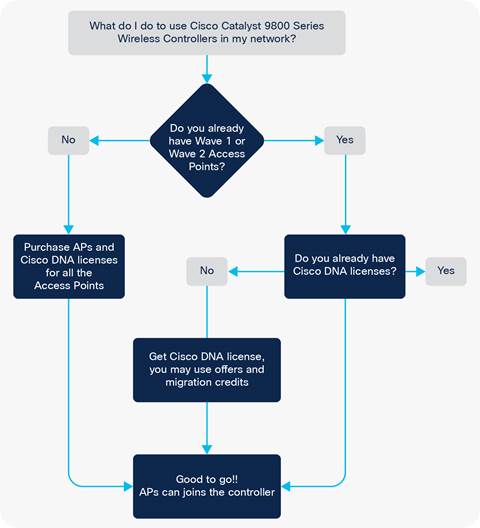
Adding a Cisco Catalyst 9800 Series controller to your network
The APs connecting to the Cisco Catalyst 9800 Series have a new and simplified licensing package.
They can support three types of Cisco DNA license: Cisco DNA Essentials, Cisco DNA Advantage, and Cisco DNA Premier.
The Cisco DNA licenses provide Cisco innovations on the access points. The license also includes the Network Essentials and Network Advantage licensing options, which cover wireless fundamentals such as 802.1X authentication, QoS, PnP, etc., telemetry and visibility, and SSO, as well as security controls. These Network Essentials and Network Advantage components are perpetual and are valid throughout the life of the AP. Cisco DNA subscription licenses have to be purchased for a 3-, 5-, or 7-year subscription term. Upon expiration of a Cisco DNA license, the Cisco DNA features will expire, but the Network Essentials and Network Advantage features will remain.
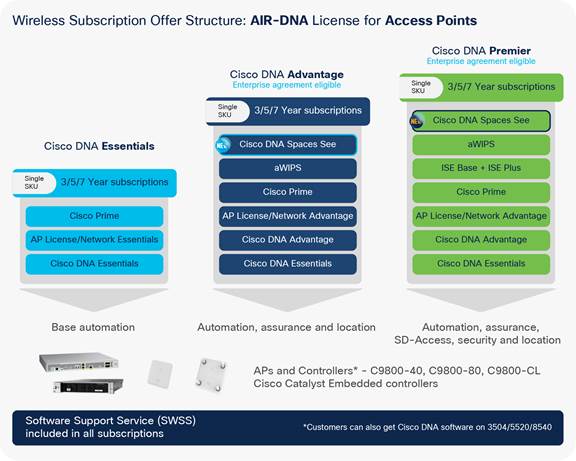
Wireless subscription offer structure
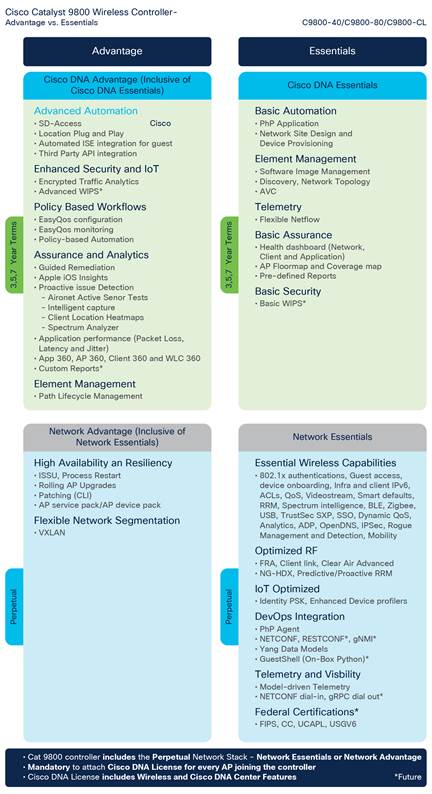
Advantage vs. Essentials licenses
The following figures and tables show what each base and add-on package includes.
Note: It is not required to deploy Cisco DNA Center just to use one of the above packages.
The following table shows the features included in the Network Advantage and Network Essentials package.
|
Feature |
Network Essentials |
Network Advantage |
|
Essential capabilities |
✓ |
✓ |
|
Optimized RF |
✓ |
✓ |
|
Internet of Things (IoT) optimized Identity Pre-Shared Keys (PSK), enhanced device profilers |
✓ |
✓ |
|
DevOps integration |
✓ |
✓ |
|
Federal certifications Federal Information Processing Standards (FIPS), CC, UCAPL, USGV6 |
✓ |
✓ |
|
Telemetry and visibility |
✓ |
✓ |
|
High availability and resiliency (advanced) |
✗ |
✓ |
|
Flexible network segmentation |
✗ |
✓ |
Features included in the Cisco DNA Advantage and Cisco DNA Essentials packages
|
Feature |
Cisco DNA Essentials |
Cisco DNA Advantage/Premier |
|
Base automation Plug and Play, network site design and device provisioning |
✓ |
✓ |
|
Element management Image management, network topology and discovery, Application Visibility and Control (AVC) |
✓ |
✓ |
|
Base assurance Health dashboard (network, client, and application), AP floor map and coverage map, predefined reports |
✓ |
✓ |
|
Telemetry Flexible NetFlow |
✓ |
✓ |
|
Base security Basic wireless IPS |
✓ |
✓ |
|
Advanced automation SD-Access Location Plug and Play Automated ISE integration for guest Third-party API integration |
✗ |
✓ |
|
Assurance and analytics Guided remediation Apple iOS Insights Proactive issue detection Aironet Active Sensor tests Intelligent capture Client location heatmaps Spectrum analyzer Application performance (packet loss, latency, and jitter) App 360, AP 360, Client 360, and WLC 360 Custom reports |
✗ |
✓ |
|
Enhanced security and Internet of Things (IoT) Encrypted Traffic Analytics, advanced wireless intrusion prevention (wIPS) |
✗ |
✓ |
|
Policy-based workflow EasyQoS configuration, EasyQoS monitoring, policy-based automation |
✗ |
✓ |
|
Element management Patch lifecycle management |
✗ |
✓ |
Two modes of licensing are available:
- SL: Smart Licensing simplifies and adds flexibility to licensing. It is:
◦ Simple: Procure, deploy, and manage licenses easily. Devices self-register, removing the need for Product Activation Keys (PAKs).
◦ Flexible: Pool license entitlements in a single account. Move licenses freely through the network, wherever you need them.
◦ Smart: Manage your license deployments with real-time visibility into ownership and consumption.
- SLR mode
◦ Specific License Reservation (SLR) is a feature used in highly secure networks. It provides a method for customers to deploy a software license on a device (product instance) without communicating usage information to Cisco. There will be no communication with Cisco or a satellite. The licenses will be reserved for every controller. It is node-based licensing.
- Four levels of licensing are supported on the Cisco Catalyst 9800 Series Wireless Controllers. The controllers can be configured to function at any one of the four levels.
◦ Cisco DNA Essentials: Supports the Cisco DNA Essentials feature set.
◦ Cisco DNA Advantage: Supports the Cisco DNA Advantage feature set.
◦ NE: Supports the Network Essentials feature set.
◦ NA: Supports the Network Advantage feature set.
- For customers who purchase Cisco DNA Essentials, Network Essentials will be supported and will continue to function even after term expiration. For customers who purchase Cisco DNA Advantage, Network Advantage will be supported and will continue to function even after term expiration.
- Initial bootup of the controller is at the Cisco DNA Advantage level.
- For questions, contact the Cisco Catalyst 9800 Series Wireless Controllers Licensing mailer group at ask-catalyst9800 licensing.
Managing licenses with Smart Accounts
Creating Smart Accounts by using the Cisco Smart Software Manager (SSM) enables you to order devices and licensing packages and also manage your software licenses from a centralized website. You can set up the Smart Account to receive daily email alerts and to be notified of expiring add-on licenses that you want to renew. A Smart Account is mandatory for Cisco Catalyst 9800 Series controllers
|
Type |
Product ID |
Description |
|
Wireless controller |
C9800-80-K9 |
Cisco Catalyst 9800-80 Wireless Controller |
|
LIC-C9800-DTLS-K9 |
Cisco Catalyst 9800 Series Wireless Controller DTLS License |
|
|
Accessories, spares |
C9800-AC-1100W= |
Cisco Catalyst Wireless Controller 1100 AC Power Supply |
|
C9800-DC-950W= |
Cisco Catalyst Wireless Controller 950W DC Power Supply |
|
|
C9800-18X1GE(=) |
Cisco Catalyst 9800-80 GE Module |
|
|
C9800-10X10E(=) |
Cisco Catalyst 9800-80 10 GE Module |
|
|
C9800-1X40GE(=) |
Cisco Catalyst 9800-80 1 Port 40 GE Module |
|
|
C9800-2X40GE(=) |
Cisco Catalyst 9800-80 2 Ports 40 GE Module |
|
|
C9800-1X100GE(=) |
Cisco Catalyst 9800-80 1 Port 100 GE Module |
Bảo hành 12 tháng
Sản phẩm xem thêm
Bộ điều khiển không dây Cisco Catalyst C9800-40-K9 Wireless Controller
Cisco Catalyst 9800-40 Wireless Controller
Bộ điều khiển không dây Cisco Catalyst C9800-CL-K9 Wireless Controller for Cloud
Cisco Catalyst 9800-CL Wireless Controller for Cloud
Bộ điều khiển không dây Cisco Catalyst C9800-L-C-K9 Wireless Controller
Cisco Catalyst 9800-L Wireless Controller_Copper Uplink
Bộ điều khiển không dây Cisco Catalyst C9800-L-F-K9 Wireless Controller
Cisco Catalyst 9800-L Wireless Controller_Fiber Uplink
Chủ sở hữu Website thietbicisco.vn thuộc về:
CÔNG TY TRÁCH NHIỆM HỮU HẠN THƯƠNG MẠI DỊCH VỤ KẾT NỐI MẠNG
Tên quốc tế: KET NOI MANG SERVICE TRADING COMPANY LIMITED
Tên viết tắt: KET NOI MANG SERVICE TRADING CO.,LTD
Số chứng nhận ĐKKD: 0314815571
Ngày cấp: 03/01/2018, nơi cấp: Sở KH & ĐT TPHCM
Người đại diện: VĂN NHẬT TÂN
Địa chỉ: Số 36/34 Đường Nguyễn Gia Trí, Phường Thạnh Mỹ Tây, Thành phố Hồ Chí Minh, Việt Nam
Địa chỉ giao dịch: 1061 Phạm Văn Đồng, Phường Linh Xuân, Thành phố Hồ Chí Minh, Việt Nam
Điện thoại: 84.028.35125568
Hotline: 09 014 014 86
Website: ketnoimang.vn | thietbifortinet.vn | thietbicisco.vn | knmrack.vn | alocafe.vn
Email: sales@ketnoimang.vn

























